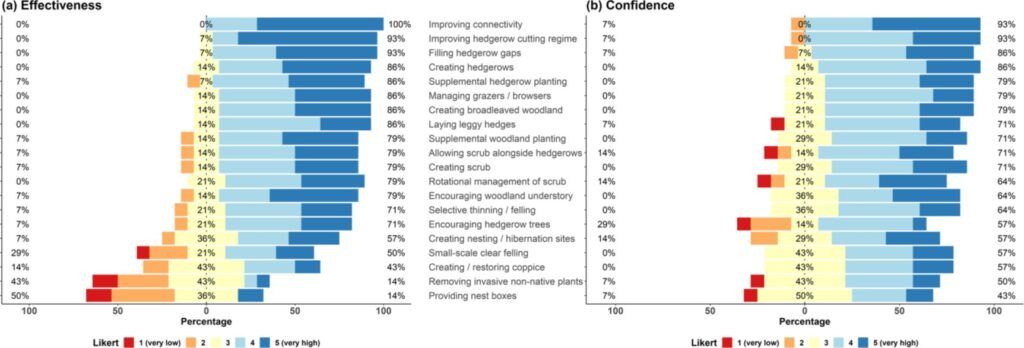Bridging the knowledge gap
Hazel dormice have long been the focus of conservation efforts in Britain. In the 1990s Pat Morris and Paul Bright studied them, laying the foundation for the understanding of their ecology and behaviour. Over the years, the scope of research has expanded, not just through academic studies, but also through the invaluable contributions of conservation volunteers and ecological consultants actively monitoring dormice in the field.
In 2022, Ben Phillips of Exeter University conducted important research to bridge the knowledge gap between academic research and practical conservation. He interviewed 38 conservation professionals (and one amateur naturalist) in Dorset and Devon, gathering valuable insights on dormouse ecology and conservation strategies. These perspectives revealed a shift in the understanding of dormouse habitats, behaviour, and movement.
Dormice are more adaptable than we thought
Dormice have traditionally been regarded as woodland species, but the findings of this research suggest they’re much more adaptable than previously thought. They’re found in a variety of habitats, including hedgerows and scrub, road and railway verges, coastal areas and gardens and flood-prone regions. This shows that dormice are not solely tied to broadleaf woodlands. As a result, conservation efforts can expand to include a much broader range of habitats, offering new opportunities to restore populations. Strategies such as improving hedgerow management, planting new woodlands, and restoring degraded habitats can help restore dormouse populations.
Participants emphasised the need for landscape-scale approaches to try and account for the impacts of climate change, and better surveying and monitoring. Key practical considerations included providing better advice, knowledge and training, changing attitudes of landowners and managers and balancing other demands such as agricultural productivity and the requirements of other species.
Despite the insights they provided, participants highlighted many remaining knowledge gaps. These included uncertainties arising from the published literature, as well as scarcely studied topics that are of major practical importance, namely the effectiveness of dormouse mitigation measures in planning and development, and the impacts of human disturbance and pollution on dormice.
Hazel dormice ecology
Dormice have primarily been characterised as a conservative woodland species but there is a growing body of evidence that suggests that scrub habitats are important. Many participants echoed this change from what they described as a traditional view and instead argued that dormice are more accurately described as a woodland edge or scrub species. Some practitioners also emphasised that dormice are more adaptable than widely perceived, in terms of the habitats, nest sites and food and nesting resources they will use. Participants described finding dormice in heathland, culm grassland, gardens, central reservations of highways, coastal areas, including those prone to flooding, and in nest tubes attached only to wire fencing. Dormice were also reported to have been found in closely flailed hedgerows, in apparently poor-quality woodlands and road verges, and in small, isolated pockets of high-quality habitats.
Three characteristics of favourable habitats were repeatedly highlighted as being important and are well supported by the scientific literature. These were:
- a dense three-dimensional habitat structure to facilitate movement, and to provide food, nest sites and protection from predators,
- a diversity of plant species and habitats to provide nesting materials and continuity of food resources throughout the year,
- connectivity both within and between habitats.
Movement and dispersal
Much of the scientific literature claims that dormice are almost entirely arboreal and averse to crossing open ground. This assertion is largely based on early radio tracking studies. For example, one study found that dormice never crossed a 6m hedgerow gap. Generally, many participants highlighted their experience that the movement and dispersal capabilities of dormice are probably much greater than widely perceived. It was reported that dormice are frequently found in isolated habitat patches and will cross woodland rides, gaps in hedgerows (e.g. gateways) and roads, which has also been reported in the scientific literature. Nonetheless, connectivity was universally mentioned as being critical for dormice. Open areas were considered to at least discourage movement, and perhaps to be absolute barriers in some cases.
Nesting and hibernation
Dormice are known to create summer nests in a variety of locations, including in natural cavities, and woven nests in hedgerows and scrub. However, one participant suggested that dormice tend to be outcompeted for natural cavities in mature trees by nesting birds.
In terms of hibernation, it was stated that dormice choose to nest on the floor in the open and may even move outside of a woodland or hedgerow to do so. This was suggested as being far more typical than in log piles, or in the roots of old coppice stools, or at the base of hedgerows, as has been claimed in some conservation documents.

FIGURE 1 Summary results of a survey of practitioner knowledge, asking non-academic dormouse experts about: (a) how effective they perceived different management actions to be for restoring hazel dormouse populations; (b) how confident they were about that assertation in each case.
Conservation measures for restoring dormouse populations
When participants were asked what they thought needed to be done to restore dormouse populations, the most frequently mentioned opportunities were:
- improving hedgerow management,
- creating new woodlands,
- bringing existing woodlands back into management
- setting aside unproductive land
- improving habitat connectivity.
These interventions were perceived as being effective, if conducted at sufficient scale, and plausible, if sufficient mechanisms were put in place.
Conclusions
The findings of the report improve the evidence base for restoring hazel dormouse populations and for further empirical evidence gathering. More generally, the study highlights how practitioner knowledge can help both to supplement traditional published evidence and to better frame conservation programmes, which may lead to more successful outcomes.
B.B. Phillips, S.L.Crowley, O.Bell, R.A. McDonald (2022) Harnessing practitioner knowledge to inform the conservation of a protected species, the hazel dormouse Muscardinus avellanarius. https://besjournals.onlinelibrary.wiley.com/doi/10.1002/2688-8319.12198.
Header image credit Sandaru-KGL, shutterstock.com
